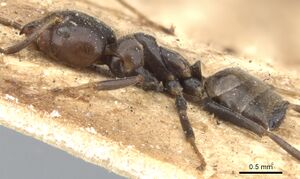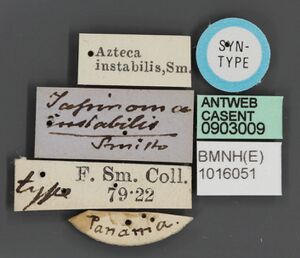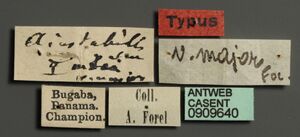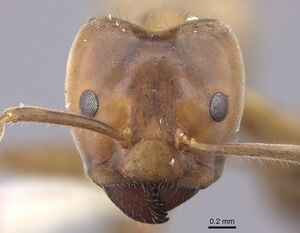Azteca instabilis
| Azteca instabilis | |
|---|---|

| |
| Scientific classification | |
| Kingdom: | Animalia |
| Phylum: | Arthropoda |
| Class: | Insecta |
| Order: | Hymenoptera |
| Family: | Formicidae |
| Subfamily: | Dolichoderinae |
| Tribe: | Leptomyrmecini |
| Genus: | Azteca |
| Species: | A. instabilis |
| Binomial name | |
| Azteca instabilis (Smith, F., 1862) | |
| Synonyms | |
| |
The largest species in the genus. Azteca instabilis forms nests in the hollow trunks of trees which have a large crevice or fissure at the base and has large, long-lived colonies.
Identification
Longino (2007) - Azteca instabilis queens are readily identified by the large size and large ocelli. Azteca gnava and Azteca sericeasur are similarly large but have much smaller ocelli (OCW < 0.15mm). Larger workers of A. instabilis are identified by the dull dorsal surface of the mandibles, large size, and densely setose tibiae.
Keys including this Species
Distribution
Mexico to Brazil.
Latitudinal Distribution Pattern
Latitudinal Range: 20.4167° to -26.84805556°.
| North Temperate |
North Subtropical |
Tropical | South Subtropical |
South Temperate |
- Source: AntMaps
Distribution based on Regional Taxon Lists
Neotropical Region: Belize, Brazil, Colombia, Costa Rica, French Guiana, Guatemala, Guyana, Honduras, Mexico, Panama (type locality), Peru, Suriname.
Distribution based on AntMaps
Distribution based on AntWeb specimens
Check data from AntWeb
Countries Occupied
| Number of countries occupied by this species based on AntWiki Regional Taxon Lists. In general, fewer countries occupied indicates a narrower range, while more countries indicates a more widespread species. |

|
Estimated Abundance
| Relative abundance based on number of AntMaps records per species (this species within the purple bar). Fewer records (to the left) indicates a less abundant/encountered species while more records (to the right) indicates more abundant/encountered species. |

|
Biology
Longino (2007) - Azteca instabilis is the largest species in the genus. It occurs in wet to dry forest habitats, usually below 500m elevation.
Azteca instabilis makes its nest in the hollow trunks of trees which have a large crevice or fissure at the base. When I encounter them, workers are issuing from the fissure in large numbers, usually ascending the tree and often blanketing the surrounding forest floor. In one case I was able to peer up into such a fissure, and I observed a very large carton nest filling the trunk cavity. Colonies can be long-lived. During extended field work at Sirena in Corcovado National Park, I frequently passed a large tree with a very active A. instabilis colony in the trunk, with workers flowing in and out of a large fissure at the base. I returned to the site 16 years later to find the same fissure with A. instabilis workers still active.
When examining Azteca queens in museum collections, A. instabilis is usually the most abundant species because the large queens frequently come to lights at night. This is in sharp contrast to most other Azteca, whose alate queens are usually encountered as diurnal strays, occasional specimens in Malaise traps, or parts of nest collections. This correlates with the fact that A. instabilis queen ocelli are absolutely and relatively far larger than ocelli on any other Azteca queen I have examined. The enlarged ocelli are not the result of an allometric relationship with head size, since Azteca sericea and Azteca sericeasur, with queens nearly as large, have tiny ocelli typical of smaller queens. Ocelli concentrate light and detect light of low intensity (Chapman 1982), suggesting a functional relationship between large ocelli and nocturnal habits.
Workers frequently forage on the surface, both day and night. They visit extrafloral nectaries, and may tend coccoid Hemiptera under small carton shelters.
DaRocha et al. (2015) studied the diversity of ants found in bromeliads of a single large tree of Erythrina, a common cocoa shade tree, at an agricultural research center in Ilheus, Brazil. Forty-seven species of ants were found in 36 of 52 the bromeliads examined. Bromeliads with suspended soil and those that were larger had higher ant diversity. A. instabilis was found in 23 different bromeliads but was associated with twigs and bark cavities, rather than suspended soil or litter, of the plants.
Flight Period
| X | X | X | X | X | X | X | X | X | X | X | X |
| Jan | Feb | Mar | Apr | May | Jun | Jul | Aug | Sep | Oct | Nov | Dec |
Source: Kaspari et al., 2001.
- Check details at Worldwide Ant Nuptial Flights Data, AntNupTracker and AntKeeping.
- Explore: Show all Flight Month data or Search these data. See also a list of all data tables or learn how data is managed.
Castes
Worker
Images from AntWeb
   
| |
| Syntype of Azteca instabilis. Worker. Specimen code casent0903009. Photographer Will Ericson, uploaded by California Academy of Sciences. | Owned by NHMUK, London, UK. |
   
| |
| Syntype of Azteca instabilis major. Worker. Specimen code casent0903010. Photographer Will Ericson, uploaded by California Academy of Sciences. | Owned by NHMUK, London, UK. |
   
| |
| Syntype of Azteca instabilis major. Worker (major/soldier). Specimen code casent0909639. Photographer Will Ericson, uploaded by California Academy of Sciences. | Owned by MHNG, Geneva, Switzerland. |
   
| |
| Syntype of Azteca instabilis major. Worker. Specimen code casent0909640. Photographer Will Ericson, uploaded by California Academy of Sciences. | Owned by MHNG, Geneva, Switzerland. |
   
| |
| Worker. Specimen code inbiocri001280964. Photographer Will Ericson, uploaded by California Academy of Sciences. | Owned by JTLC. |
   
| |
| Worker. Specimen code jtlc000009539. Photographer Shannon Hartman, uploaded by California Academy of Sciences. | Owned by PSWC. |
Queen
Images from AntWeb
    
| |
| Queen (alate/dealate). Specimen code jtlc000009445. Photographer Will Ericson, uploaded by California Academy of Sciences. | Owned by JTLC. |
Nomenclature
The following information is derived from Barry Bolton's Online Catalogue of the Ants of the World.
- instabilis. Tapinoma instabilis Smith, F. 1862b: 31 (w.) PANAMA.
- Emery, 1893b: 135 (s.); Emery, 1896b: 2 (q.); Wheeler, G.C. & Wheeler, J. 1951: 193 (l.).
- Combination in Liometopum: Mayr, 1878: 870;
- combination in Azteca: Emery, 1893b: 135.
- Status as species: Roger, 1863b: 14; Mayr, 1863: 455; Mayr, 1878: 870; Forel, 1886a: 217; Dalla Torre, 1893: 163; Emery, 1893b: 135 (redescription); von Jhering, 1894: 379; Emery, 1896b: 2; Forel, 1899c: 107; Emery, 1906c: 174; Wheeler, W.M. 1907a: 275; Emery, 1913a: 33; Santschi, 1913h: 41; Wheeler, W.M. 1916c: 12; Crawley, 1916b: 375; Mann, 1922: 51; Borgmeier, 1923: 93; Menozzi, 1935b: 199; Wheeler, W.M. 1942: 229; Kempf, 1972a: 32; Shattuck, 1994: 19; Bolton, 1995b: 79; Longino, 2007: 35 (redescription); Branstetter & Sáenz, 2012: 253; Bezděčková, et al. 2015: 108; Guerrero, 2019: 706.
- Senior synonym of major: Longino, 2007: 35.
- major. Azteca instabilis var. major Forel, 1899c: 107 (w.) PANAMA, COLOMBIA, FRENCH GUIANA.
- Subspecies of instabilis: Forel, 1912h: 47; Emery, 1913a: 33; Kempf, 1972a: 32; Shattuck, 1994: 19; Bolton, 1995b: 79.
- Junior synonym of instabilis: Longino, 2007: 35.
Unless otherwise noted the text for the remainder of this section is reported from the publication that includes the original description.
Description
Worker
Longino (2007) - (n=4): HLA 1.88 (1.76–2.10), HW 1.85 (1.80–2.13), SL 1.39 (1.34–1.41), CI 101 (95–102), SI 74 (67–76).
Palpal formula 6,4; middle and hind tibia with prominent pectinate apical spur; dorsal surface of mandible strongly microareolate, dull, with moderately abundant small piligerous puncta, setae in puncta short, erect, larger puncta with long setae near masticatory margin; medial and lateral clypeal lobes at about same level; head with convex sides, strongly cordate posterior margin; mesosoma in lateral profile with sloping pronotum, mesonotum forming separate convexity, posterior mesonotum and dorsal face of propodeum together forming single shallow concavity, with no notch marking metanotal groove; scape with abundant erect setae, length of setae about one half maximum width of scape; mid and hind tibia with abundant erect setae, longest setae about one half maximum width of tibia; sides of head without erect setae; posterior margin of head with abundant erect setae; pronotum, mesonotum, and dorsal face of propodeum with abundant long erect setae; color dark brown to light orange brown, if somewhat bicolored gaster is darker then mesosoma.
Queen
Longino (2007) - (n=5): HLA 2.49 (2.42–2.52), HW 2.47 (2.39–2.55), SL 1.50 (1.42–1.50), CI 100 (98–101), SI 60 (58–62).
Palpal formula 6,4; ocelli large (OCW > 0.20mm); middle and hind tibia with prominent pectinate apical spur; dorsal surface of mandible smooth, very faintly microareolate, with moderately abundant small piligerous puncta, setae in puncta short, suberect, larger puncta with long setae near masticatory margin; medial and lateral clypeal lobes at about same level (medial lobe not projecting anteriorly); head quadrate, with sides somewhat convex, cordate posteriorly; petiolar node tall, strongly compressed into thin scale at apex; posteroventral petiolar lobe evenly convex from front to back, broad and flat laterally, ending before posterior margin of sternite, leaving small rim formed by posteriormost portion of sternite; scape with abundant erect setae, about as long as one half maximum width of scape; middle and hind tibia with abundant erect setae, longest of these about as long as one half maximum width of tibia (MTSC 30–35); sides of head without erect setae; posterior margin of head with abundant erect setae; pronotum with erect setae on anterior and posterior margins, absent from medial area; mesoscutum, scutellum, and propodeum with abundant erect setae; petiolar node with variable number of long setae on apex, abundant long setae on posteroventral lobe; all gastral terga with abundant erect setae; color red brown.
Type Material
Longino (2007) - Syntype workers: Panama The Natural History Museum (examined).
References
- Adams, R.M.M., Wells, R.L., Yanoviak, S.P., Frost, C.J., Fox, E.G.P. 2020. Interspecific Eavesdropping on Ant Chemical Communication. Frontiers in Ecology and Evolution 8. (doi:10.3389/fevo.2020.00024).
- Albuquerque, E., Prado, L., Andrade-Silva, J., Siqueira, E., Sampaio, K., Alves, D., Brandão, C., Andrade, P., Feitosa, R., Koch, E., Delabie, J., Fernandes, I., Baccaro, F., Souza, J., Almeida, R., Silva, R. 2021. Ants of the State of Pará, Brazil: a historical and comprehensive dataset of a key biodiversity hotspot in the Amazon Basin. Zootaxa 5001, 1–83 (doi:10.11646/zootaxa.5001.1.1).
- Cantone S. 2017. Winged Ants, The Male, Dichotomous key to genera of winged male ants in the World, Behavioral ecology of mating flight (self-published).
- Cantone, S., Von Zuben, C.J. 2019. The hindwings of ants: A phylogenetic analysis. Psyche: A Journal of Entomology 2019, 1–11 (doi:10.1155/2019/7929717).
- DaRocha, W. D., S. P. Ribeiro, F. S. Neves, G. W. Fernandes, M. Leponce, and J. H. C. Delabie. 2015. How does bromeliad distribution structure the arboreal ant assemblage (Hymenoptera: Formicidae) on a single tree in a Brazilian Atlantic forest agroecosystem? Myrmecological News. 21:83-92.
- Dejean, A., Compin, A., Delabie, J.H.C., Azémar, F., Corbara, B., Leponce, M. 2019. Biotic and abiotic determinants of the formation of ant mosaics in primary Neotropical rainforests. Ecological Entomology 44, 560–570 (doi:10.1111/een.12735).
- Ellison, A.M., Gotelli, N.J. 2021. Ants (Hymenoptera: Formicidae) and humans: from inspiration and metaphor to 21st-century symbiont. Myrmecological News 31: 225-240 (doi:10.25849/MYRMECOL.NEWS_031:225).
- Emery, C. 1893l. Studio monografico sul genere Azteca Forel. Mem. R. Accad. Sci. Ist. Bologna (5)3:119-152 (page 135, soldier described, combination in Azteca)
- Emery, C. 1896b. Alcune forme nuove del genere Azteca For. e note biologiche. Boll. Mus. Zool. Anat. Comp. R. Univ. Torino 11(2 230: 1-7 (page 2, queen described)
- Franco, W., Ladino, N., Delabie, J.H.C., Dejean, A., Orivel, J., Fichaux, M., Groc, S., Leponce, M., Feitosa, R.M. 2019. First checklist of the ants (Hymenoptera: Formicidae) of French Guiana. Zootaxa 4674, 509–543 (doi:10.11646/zootaxa.4674.5.2).
- Kaspari, M., Pickering, J., Longino, J., Windsor, D. 2001. The phenology of a Neotropical ant assemblage: evidence for continuous and overlapping reproduction. Behavioral Ecology and Sociobiology 50, 382–390 (doi:10.1007/s002650100378).
- Khazan, E., Bujan, J., Scheffers, B.R. 2020. Patterns of ant activity and nesting ecology depend on flooding intensity in a Neotropical floodplain. International Journal of Tropical Insect Science (doi:10.1007/s42690-020-00149-0).
- Longino, J.T. 2007. A taxonomic review of the genus Azteca in Costa Rica and a global revision of the aurita group. Zootaxa. 1491:1-63.
- Mayr, G. 1878 [1877]. Formiciden gesammelt in Brasilien von Professor Trail. Verh. K-K. Zool.-Bot. Ges. Wien 27: 867-878 (page 870, combination in Liometopum)
- Schmitt, L., Aponte‐Rolón, B., Perfecto, I. 2020. Evaluating community effects of a Keystone Ant, Azteca sericeasur, on Inga micheliana leaf litter decomposition in a shaded coffee agro‐ecosystem. Biotropica 52, 1253–1261 (doi:10.1111/btp.12833).
- Smith, F. 1862b. Descriptions of new species of aculeate Hymenoptera, collected at Panama by R. W. Stretch, Esq., with a list of described species, and the various localities where they have previously occurred. Trans. Entomol. Soc. Lond. (3) 1: 29-44 (page 31, worker described)
- Wheeler, G. C.; Wheeler, J. 1951. The ant larvae of the subfamily Dolichoderinae. Proc. Entomol. Soc. Wash. 53: 169-210 (page 193, larva described)
- Wheeler, W. M. 1907b. A collection of ants from British Honduras. Bull. Am. Mus. Nat. Hist. 23: 271-277 (page 276, see also)
References based on Global Ant Biodiversity Informatics
- Achury R., P. Chacon de Ulloa, and A. M. Arcila. 2008. Ant composition and competitive interactions with Wasmannia auropunctata in Tropical Dry Forest fragments. Revista Colombiana de Entomología 34 (2): 209-216.
- Adams B. J., S. A. Schnitzer, and S. P. Yanoviak. 2019. Connectivity explains local ant community structure in a Neotropical forest canopy: a large-scale experimental approach. Ecology 100(6): e02673.
- Antoniazzi R., R. N. S. L. Garoo, W. Dattilo, S. P. Ribeiro, and F. S. Neves. 2019. Ant species richness and interactions in canopies of two distinct successional stages in a tropical dry forest. The Science of Nature 106: 20
- Armbrecht I., E. Jimenez, G. Alvarez, P. Ulloa-Chacon, and H. Armbrecht. 2001. An ant mosaic in the Colombian rain forest of Choco (Hymenoptera: formicidae0. Sociobiology 37(3B): 491-509.
- Basset Y., L. Cizek, P. Cuenoud, R. K. Didham, F. Guilhaumon, O. Missa, V. Novotny, F. Odegaards, T. Roslin, J. Schmidl et al. 2012. Arthropod diversity in a tropical forest. Science 338(6113): 1481-1484.
- Bezdeckova K., P. Bedecka, and I. Machar. 2015. A checklist of the ants (Hymenoptera: Formicidae) of Peru. Zootaxa 4020 (1): 101–133.
- Borgmeier T. 1923. Catalogo systematico e synonymico das formigas do Brasil. 1 parte. Subfam. Dorylinae, Cerapachyinae, Ponerinae, Dolichoderinae. Archivos do Museu Nacional (Rio de Janeiro) 24: 33-103.
- Branstetter M. G. and L. Sáenz. 2012. Las hormigas (Hymenoptera: Formicidae) de Guatemala. Pp. 221-268 in: Cano E. B. and J. C. Schuster. (eds.) 2012. Biodiversidad de Guatemala. Volumen 2. Guatemala: Universidad del Valle de Guatemala, iv + 328 pp
- Castano-Meneses, G., M. Vasquez-Bolanos, J. L. Navarrete-Heredia, G. A. Quiroz-Rocha, and I. Alcala-Martinez. 2015. Avances de Formicidae de Mexico. Universidad Nacional Autonoma de Mexico.
- Chacon de Ulloa P., A. M. Osorio-Garica, R. Achury, and C. Bermudez-Rivas. 2012. Hormigas (Hymenoptera: Formicidae) del Bosque seco tropical (Bs-T) de la cuenca alta del rio Cauca, Colombia. Biota Colombiana 13(2): 165-181.
- Crawley W. C. 1916. Ants from British Guiana. Ann. Mag. Nat. Hist. 8(17): 366-378.
- Dattilo W. et al. 2019. MEXICO ANTS: incidence and abundance along the Nearctic-Neotropical interface. Ecology https://doi.org/10.1002/ecy.2944
- Dejean A., A. Compin, J. H. C. Delabie, F. Azemar, B. Corbara, and M. Leponce. 2019. Biotic and abiotic determinants of the formation of ant mosaics in primary Neotropical rainforests. Ecological Entomology https://doi-org.eproxy.lib.hku.hk/10.1111/een.12735
- Dejean, A., S. Durou, I. Olmsted, R.R. Snelling and J. Orivel. 2003. Nest Site Selection by Ants in a Flooded Mexican Mangrove, with Special Reference to the Epiphytic Orchid Myrmecophila christinae. Journal of Tropical Ecology 19(3) :325-331
- Dejean, A., S. Durou, I. Olmsted, R.R. Snelling and J. Orivel. 2003. Nest Site Selection by Ants in a Flooded Mexican Mangrove, with Special Reference to the Epiphytic Orchid Myrmecophila christinae. Journal of Tropical Ecology 19(3):325-331
- Del Toro, I., M. Vázquez, W.P. Mackay, P. Rojas and R. Zapata-Mata. Hormigas (Hymenoptera: Formicidae) de Tabasco: explorando la diversidad de la mirmecofauna en las selvas tropicales de baja altitud. Dugesiana 16(1):1-14.
- Emery C. 1896. Studi sulle formiche della fauna neotropica. XVII-XXV. Bullettino della Società Entomologica Italiana 28: 33-107.
- Emery C. 1913. Hymenoptera. Fam. Formicidae. Subfam. Dolichoderinae. Genera Insectorum 137: 1-50.
- Fernández, F. and S. Sendoya. 2004. Lista de las hormigas neotropicales. Biota Colombiana Volume 5, Number 1.
- Fisher B. L., L. da Silveira Lobo Sternber, and D. Price. 1990. Variation in the use of orchid extrafloral nectar by ants. Oecologia 83: 263-266.
- Franco W., N. Ladino, J. H. C. Delabie, A. Dejean, J. Orivel, M. Fichaux, S. Groc, M. Leponce, and R. M. Feitosa. 2019. First checklist of the ants (Hymenoptera: Formicidae) of French Guiana. Zootaxa 4674(5): 509-543.
- Gonthier, D. J., G. L. Pardee, and S. M. Philpott. 2010. Azteca instabilis ants and the defence of a coffee shade tree: an ant-plant association without mutual rewards in Chiapas, Mexico. Journal of Tropical Ecology 26: 343-346.
- Gonthier, D. J., G. M. Dominguez, J. D. Witter, A. L. Spongberg, and S. M. Philpott. 2013. Bottom-up effects of soil quality on a coffee arthropod interaction web. Ecosphere 4: 1-15.
- Gonthier, D. J., K. K. Ennis, S. M. Philpott, J. Vandermeer, and I. Perfecto. 2013. Ants defend coffee from berry borer colonization. BioControl 58: 815-820.
- Groc S., J. Orivel, A. Dejean, J. Martin, M. Etienne, B. Corbara, and J. H. C. Delabie. 2009. Baseline study of the leaf-litter ant fauna in a French Guianese forest. Insect Conservation and Diversity 2: 183-193.
- INBio Collection (via Gbif)
- Jha, S., J. H. Vandermeer, and I. Perfecto. 2009. Population dynamics of Coccus viridis, a ubiquitous ant-tended agricultural pest, assessed by a new photographic method. Bulletin of Insectology 62: 183-189.
- Kempf, W.W. 1972. Catalago abreviado das formigas da regiao Neotropical (Hym. Formicidae) Studia Entomologica 15(1-4).
- Liere, H., I. Perfecto, and J. Vandermeer. 2014. Stage-dependent responses to emergent habitat heterogeneity: consequences for a predatory insect population in a coffee agroecosystem. Ecology and Evolution 4: 3201-3209.
- Liere, H., and I. Perfecto. 2008. Cheating on a mutualism: indirect benefits of ant attendance to a coccidophagous coccinellid. Environmental Entomology 37: 143-149.
- Livingston, G. F., A. M. White, and C. J. Kratz. 2008. Indirect interactions between ant-tended hemipterans, a dominant ant Azteca instabilis (Hymenoptera: Formicidae), and shade trees in a tropical agroecosystem. Environmental Entomology 37: 734-740.
- Longino J. T. 2007. A taxonomic review of the genus Azteca (Hymenoptera: Formicidae) in Costa Rica and a global revision of the aurita group. Zootaxa 1491: 1-63
- Longino J. et al. ADMAC project. Accessed on March 24th 2017 at https://sites.google.com/site/admacsite/
- Longino, J.T. 2010. Personal Communication. Longino Collection Database
- Lutinski J. A., B. C. Lopes, and A. B. B.de Morais. 2013. Diversidade de formigas urbanas (Hymenoptera: Formicidae) de dez cidades do sul do Brasil. Biota Neotrop. 13(3): 332-342.
- Maes, J.-M. and W.P. MacKay. 1993. Catalogo de las hormigas (Hymenoptera: Formicidae) de Nicaragua. Revista Nicaraguense de Entomologia 23.
- Majer J. D., and J. H. C. Delabie. 1994. Comparison of the ant communities of annually inundated and terra firme forests at Trombetas in the Brazilian Amazon. Insectes Sociaux 41: 343-359.
- Mann W. M. 1922. Ants from Honduras and Guatemala. Proceedings of the United States National Museum 61: 1-54.
- Marin, L., and I. Perfecto. 2013. Spider diversity in coffee agroecosystems: the influence of agricultural intensification and aggressive ants. Environmental Entomology 42: 204-213.
- Menozzi C. 1935. Spedizione del Prof. Nello Beccari nella Guiana Britannica. Hymenoptera-Formicidae. Redia. 21: 189-203.
- Mirmecofauna de la reserva ecologica de San Felipe Bacalar
- Neves F. S., K. S. Queiroz-Dantas, W. D. da Rocha, and J. H. C. Delabie. 2013. Ants of Three Adjacent Habitats of a Transition Region Between the Cerrado and Caatinga Biomes: The Effects of Heterogeneity and Variation in Canopy Cover. Neotrop Entomol 42: 258268.
- Pardee, G. L., and S. M. Philpott. 2011. Cascading indirect effects in a coffee agroecosystem: effects of parasitic phorid flies on ants and the coffee berry borer in a high-shade and low-shade habitat. Environmental Entomology 40: 581-588.
- Perfecto, I., and J. Vandermeer. 2006. The effect of an ant-hemipteran mutualism on the coffee berry borer (Hypothenemus hampei) in southern Mexico. Agriculture, Ecosystems & Environment 117: 218-221.
- Philpott, S. M. 2005. Changes in arboreal ant populations following pruning of coffee shade-trees in Chiapas, Mexico. Agroforestry Systems 64: 219-224.
- Philpott, S. M. 2006. Ant patchiness: a spatially quantitative test in coffee agroecosystems. Naturwissenschaften 93: 386-392.
- Philpott, S.M. and P.F. Foster. 2005. Nest-site limitation in coffee agroecosytems: Artificial nests maintain diversity of arboreal ants. Ecological Applications 15(4):1478-1485
- Philpott, S.M., I. Perfecto and J. Vandermeer. 2008. Effects of predatory ants on lower trophic levels across a gradient of coffee management complexity. Journal of Animal Ecology 77:505511
- Philpott, S.M., R. Greenberg and P. Bichier. 2005. The Influence of Ants on the Foraging Behavior of Birds in an Agroforest. Biotropica 37(3):468-471
- Rosa da Silva R. 1999. Formigas (Hymenoptera: Formicidae) do oeste de Santa Catarina: historico das coletas e lista atualizada das especies do Estado de Santa Catarina. Biotemas 12(2): 75-100.
- Shattuck S. O. 1994. Taxonomic catalog of the ant subfamilies Aneuretinae and Dolichoderinae (Hymenoptera: Formicidae). University of California Publications in Entomology 112: i-xix, 1-241.
- Vásquez-Bolaños M. 2011. Lista de especies de hormigas (Hymenoptera: Formicidae) para México. Dugesiana 18: 95-133
- Wheeler W. M. 1907. A collection of ants from British Honduras. Bulletin of the American Museum of Natural History 23: 271-277.
- Wheeler W. M. 1942. Studies of Neotropical ant-plants and their ants. Bulletin of the Museum of Comparative Zoology 90: 1-262.

